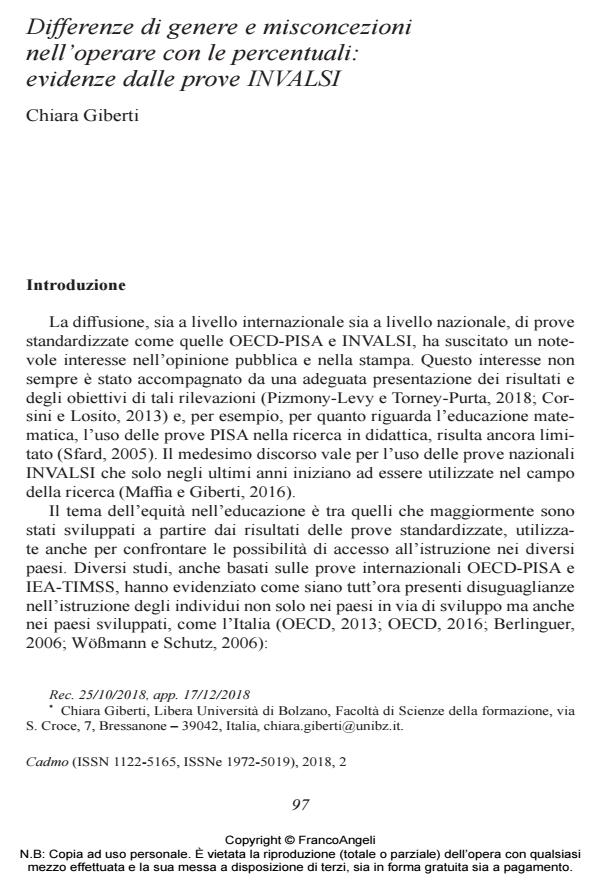Differenze di genere e misconcezioni nell’operare con le percentuali: evidenze dalle prove INVALSI
Titolo Rivista CADMO
Autori/Curatori Chiara Giberti
Anno di pubblicazione 2019 Fascicolo 2018/2 Lingua Italiano
Numero pagine 18 P. 97-114 Dimensione file 416 KB
DOI 10.3280/CAD2018-002007
Il DOI è il codice a barre della proprietà intellettuale: per saperne di più
clicca qui
Qui sotto puoi vedere in anteprima la prima pagina di questo articolo.
Se questo articolo ti interessa, lo puoi acquistare (e scaricare in formato pdf) seguendo le facili indicazioni per acquistare il download credit. Acquista Download Credits per scaricare questo Articolo in formato PDF

FrancoAngeli è membro della Publishers International Linking Association, Inc (PILA)associazione indipendente e non profit per facilitare (attraverso i servizi tecnologici implementati da CrossRef.org) l’accesso degli studiosi ai contenuti digitali nelle pubblicazioni professionali e scientifiche
;
Keywords:Gender gap; misconceptions; percentages; Rasch analysis; standardized assessment.
- Maffia, A., Giberti, C. (2016), “Didattica della matematica e PISA: strade percorse e nuovi sentieri da battere”, in L. Palmerio (a cura di), PISA 2012. Contributi di approfondimento. Milano: FrancoAngeli, pp. 190-200.
- Maffia, A., Mariotti, M.A. (2018), “Intuitive and Formal Models of Whole Numbers Multiplication: Relations and Emerging Structures”, For the Learning of Mathematics, 38 (3), pp. 30-36.
- Mullis, I.V.S., Martin, M.O., Foy, P., Hooper, M. (2016), TIMSS 2015 International Results in Mathematics. Boston: TIMSS & PIRLS International Study Center.
- OECD (2013), PISA 2012 Results: Excellence Through Equity: Giving Every Student the Chance to Succeed (Volume II). Paris: OECD Publishing.
- OECD (2016), PISA 2015 Results (Volume I): Excellence and Equity in Education. Paris: OECD Publishing.
- Ongaki, N.M., Musa, F.W. (2014), “Enhancing Socio-Economic Equity in Accessing Quality Education: A Case of Form One Selection Policy in KISII County, Kenya”, The International Journal of Business & Management, 2 (11), p. 157.
- Pajares, F. (2005), “Gender Differences in Mathematics Self-efficacy Beliefs”, in A. Gallagher, J. Kaufman (eds), Gender Differences in Mathematics: An Integrative Psychological Approach. New York: Cambridge University Press, pp. 294-315.
- Pizmony-Levy, O., Torney-Purta, J. (2018), “How Journalists and Researchers Communicate Results of International Large-Scale Assessments”, Cadmo. Giornale Italiano di Pedagogia sperimentale. An International Journal of Educational Research, 26, 1, pp. 51-65.
- Rasch, G. (1960), Probabilistic Models for Some Intelligence and Attainment Tests. Copenhagen: Danish Institute for Educational Research.
- Riegle-Crumb, C. (2005), “The Cross-national Context of the Gender Gap in Math and Science”, in L. Hedges, B. Schneider (eds), The Social Organization of Schooling. New York: Russell, pp. 227-243.
- Ryan, J., Williams, J. (2007), Children’S Mathematics 4-15: Learning from Errors and Misconceptions: Learning from Errors and Misconceptions. Maidenhead (UK): McGraw-Hill Education.
- Sbaragli, S. (2012), “Il ruolo delle misconcezioni nella didattica della matematica”, in G. Bolondi, M.I. Fandiño Pinilla (a cura di), I quaderni della didattica. Metodi e strumenti per l’insegnamento e l’apprendimento della matematica. Napoli: EDISES, pp. 121-139.
- Sfard, A. (2005), “What could be more Practical than Good Research?”, Educational Studies in Mathematics, 58 (3), pp. 393-413.
- Winkelmann, H., van den Heuvel-Panhuizen, M., Robitzsch, A. (2008), “Gender Differences in the Mathematics Achievements of German Primary School Students: Results from a German Large-scale Study”, ZDM – The International Journal on Mathematics Education, 40 (4), pp. 601-616.
- Wößmann, L., Schütz, G. (2006), “Efficiency and Equity in European Education and Training Systems”, Analytical Report for the European Commission prepared by the European Expert Network on Economics of Education. Bruxelles: European Commission.
- The Properties of Powers: Didactic Contract and Gender Gap Federica Ferretti, Chiara Giberti, in International Journal of Science and Mathematics Education /2021 pp.1717
DOI: 10.1007/s10763-020-10130-5 - Changing the Order of Factors Does Not Change the Product but Does Affect Students’ Answers, Especially Girls’ Answers Clelia Cascella, Chiara Giberti, Giorgio Bolondi, in Education Sciences /2021 pp.201
DOI: 10.3390/educsci11050201 - The role of metaphors in interpreting students’ difficulties in operating with percentages: A mixed method study based on large scale assessment Chiara Giberti, George Santi, Camilla Spagnolo, in European Journal of Science and Mathematics Education /2023 pp.297
DOI: 10.30935/scimath/12642
Chiara Giberti, Differenze di genere e misconcezioni nell’operare con le percentuali: evidenze dalle prove INVALSI in "CADMO" 2/2018, pp 97-114, DOI: 10.3280/CAD2018-002007